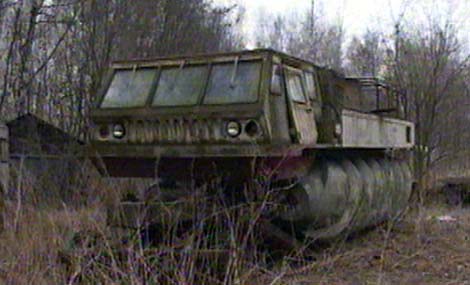
This is an armored military vehicle manufactured by Zil russian factory – year is 1970.
Who else but the Russians could ever dream up a corkscrew drive system?
The major downside on this thing is that the suspension is missing. It might be possible to mitigate that to some extent. However the screw is still rigid whereas a track can change its shape follow the terrain. That means you can use it screw propulsion for e.g. a reconnaissance vehicle in very adverse terrain but not for a battle tank, APC or medivac vehicle.
Directional stability may not be the best, it should be possible to use a regular mechanical instead of a series hybrid transmission. So the upsides are lower system complexity, better fuel economy and, lower drivetrain & fuel weight.
These are Russian screw vehicles, which seems to be an area in which they did some development.


I figure the plan was to make their enemy either scared shitless or paralyzed by awe of Russian mechanized genius/madness. Or both.
I found out that the original screw propulsion vehicle was designed in 1944, during WWII, by Johannes Raedel, a member of the German Army and veteran of the Eastern Front with Russia. (Note: Raedel was originally spelled R’a’del, with an umlaut). He had observed that in the deep snows of Russia, tanks would dig out the snow under the tracks, and the tank would become high centered on snow pressed under the belly of the tank.

According to Siegfried Raedel, son of Johannes..”The idea evolved while looking at a meat mincer, also employing a screw type of compression. He convinced army headquarters in Berlin to allow him to make a prototype of this machine. At that time, Austria was annexed to Germany already and he was dispatched to the Austrian Alpine vehicle test centre at St. Johann in Tyrol. Using whatever materials were available he built this prototype during the period of 10th Feb 1944 to 28th April 1944. It was tested extensively and the first page of this report is attached, together with a few pictures of the original. It was very slow, but it would pull 1 ton! It also had good climbing capabilities. It would penetrate about 30cm into the snow, no more.”
The photos below are of Johannes testing the vehicle in Tyrol. The woman and children were at a lodge at the top of a mountain, which the vehicle had climbed during testing.



Siegfried pointed out that “something in the order of 7 tons of patent papers were taken out of Germany after the war. What amazes me though is the fact that both the US and Russia seem to have had access to these papers – and this during the cold war period!
I also found that americans developed their own screw vehicle:
Chrysler Marsh Screw Amphibian (1964)
Same principle as the DAF screw vehicle, this one can do 14 mph in the mud 8 mph in water and in the snow up to 20 mph.
The power came from a Chrysler 225 cubic inch, 140 hp, 6 cylinder gasoline engine. An automatic gearbox was used to make the screws turn.
On hard pavement the only way to operate was to roll side ways but not at the same speed as the DAF

I can’t imagine what all those vehicles would do to a road…
Update:
This toy was build with the same tehnology,with Archimede’s screw propulsion, a very unique control system and the ability to drive on both land and water.
This post was written by bullets on July 4, 2007


You mean Rädel? It’s not that hard. (Unless you don’t have OS X…)
Tucker experimented with screw-drive snow machines in the 20’s – I don’t know if he was the very first but gas powered vehicles don’t date back much further than that.
A similar screw-drive conversion was available for Henry Ford’s Fordson tractor in the U.S. in the 1920’s.
Great site and informative.
I’m gonna read and check it all out.
Keep up the good work.
Gerard.
At the Hedrick Ag Historical museum in Yolo CA there is a Fordson Snowmobile which uses this screw drive. From the museums website:
Fordson Snowmobile 1926
This was known as an Fordson Snowmobile 1926
This was known as an Armstead Snow-motor. Hauling capacity was said to be five tons. Each drum receives power from a separate clutch which, depending on the position of the steering gear, engages and disengages. It can also traverse bare ground. This machine hauled mail from Truckee to North Lake Tahoe. Hauling capacity was said to be five tons. Each drum receives power from a separate clutch which, depending on the position of the steering gear, engages and disengages. It can also traverse bare ground. This machine hauled mail from Truckee to North Lake Tahoe.
I need to purchase it! Really! I ready to pay money for it!
I wait for an answer from anybody.
Here is a video of the 1924 FORDSON SNOW MACHINE AND SEVERAL CARS MADE ON THE SAME IDEA THEN.
http://www.flixxy.com/snow-vehicle-concept.htm
The American Patent for the I.Q.A.Peavey “Snow Locomotive” is dated Aug. 20th, 1907. At least one of these was built and if it followed the patent drawing, it was a steam driven, articulated vehicle with two sets of screw drives through linkages.
Is there some plans for a hydrostatic screw drive?
The screw is back!
http://www.diseno-art.com/articles/tesh-drive_amphibious_off-road_drive_system.html